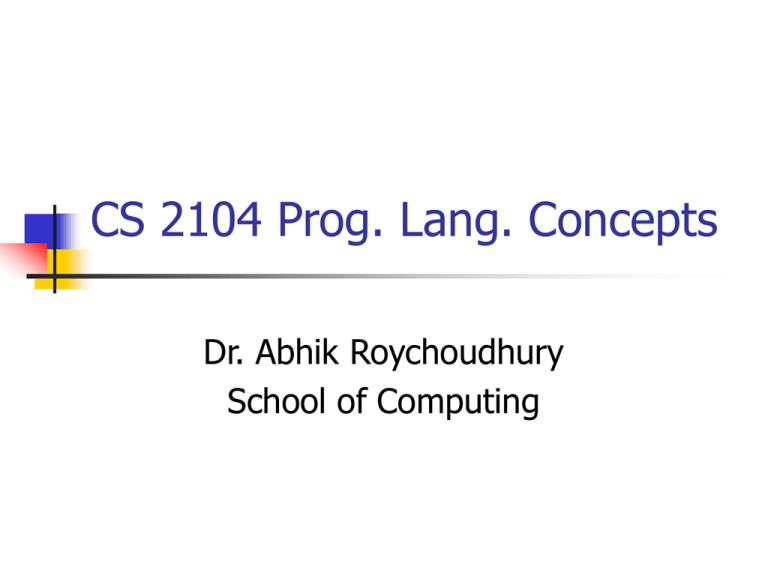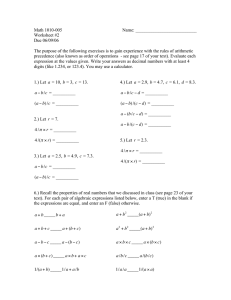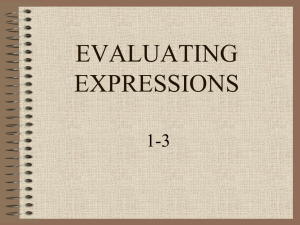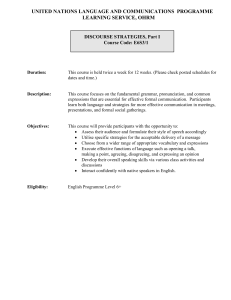Expressions
advertisement

CS 2104 Prog. Lang. Concepts
Dr. Abhik Roychoudhury
School of Computing
Today’s lecture
Finish discussion on type checking
initiated in last lecture
Discuss the role of expressions in
programming languages
Issues in Type Checking
How to type-check?
How to cater for polymorphism?
What is your definition of “compatible
type”?
When to perform type checking?
Is your language strongly or weakly
typed?
2.4 When to perform Type
Checking?
When is the variable
bound to the type?
Compile-Time
Run-Time
(Static Type Binding)
(Dynamic Type Binding)
When can I type
check?
In theory, you can choose
to type check at compile
time or run-time.
No choice but to do
dynamic type checking.
In practice, languages try to
do it as much statically as
possible.
Eg. SML, Pascal
Eg. JavaScript, APL
When to perform Type
Checking?
Static Type Checking – done at compile time.
(+) Done only once
(+) Earlier detection of errors
(–) Less Program Flexibility (Fewer shortcuts and
tricks)
2.4 When to perform Type
Checking?
Dynamic Type Checking – done at run time.
(–) Done many times
(–) Late detection of errors
(–) More memory needed, since we need to
maintain type information of all the current values
in their respective memory cells.
(–) Slows down overall execution time, since extra
code is inserted into the program to detect type
error.
(+) Program Flexibility (Allows you to ‘hack’ dirty
code.)
Issues in Type Checking
How to type-check?
How to cater for polymorphism?
What is your definition of “compatible
type”?
When to perform type checking?
Is your language strongly or weakly
typed?
2.5 Strong Type Systems
A programming language is defined to be strongly
typed if type errors are always detected
STATICALLY.
A language with a strong-type system only allows
type-safe programs to be successfully compiled into
executables. (Otherwise, language is said to have a
weak type system).
Programs of strong-type systems are guaranteed to
be executed without type-error. (The only error left
to contend with is logic error).
2.5 Strong Type Systems
Fortran
No
Ada
No
Modula-3
No
Allows variable of one type to refer to value of
another type through EQUIVALENCE keyword.
Library function UNCHECKED_CONVERSION
suspends type checking.
Same as Ada through use of keyword LOOPHOLE
C, C++
No
1. Forced conversion of type through type casting
2. Union Types can compromise type safety
Java
No
Type Casting
Pascal
Almost
Variant Records can compromise type safety
SML
Yes
Haskell
Yes
All variables have STATIC TYPE BINDING.
2.5 Weak-Type Systems:
Variant Recs
Variant Records in C (via union keyword)
compromises Type Safety
...
typedef union {
int X;
float Y;
char Z[4];} B;
...
B P;
Weak-Type Sys: Variant Recs
Variant part all have overlapping (same) L-value!!!
Problems can occur. What happens to the code below?
P.X = 142;
printf(“%O\n”, P.Z[3])
All 3 data objects have same L-value and occupy same storage.
No enforcement of type checking.
Poor language and type system design
Weak-Type Sys: Variant Recs
Variant Records in Pascal tries to overcome C’s deficiency. They have a
tagged union type.
type whichtype = (inttype, realtype,stringtype);
type uniontype = record
case V : whichtype of
inttype : (X: integer);
realtype: (Y: real);
stringtype: (Z:…)
end
But the compiler usually doesn’t check the consistency between the
variant and the tag. So we can ‘subvert’ the tagged field:
var P: uniontype
P.V = inttype;
P.X = 142;
P.V = realtype; // type safety compromised
CS 2104 – Prog. Lang. Concepts
Expressions
Lecturer : Dr. Abhik Roychoudhury
School of Computing
What is an expression ?
The notion of value is central to programming.
The allowed set of possible values of a variable denotes its type.
Program variables get instantiated to values at run-time.
Integer variables to integer values
String variables to array of characters etc.
We previously called values as r-values to distinguish between
values and addresses.
With this perspective, we could define an expression simply as:
An expression is a formal description of a value.
Examples
2
2*5
F(4) + 2*5
// Need to define function F
A<B
A < B \/ C = D
// A,B,C,D are variables
P(A, B) \/ Q(C, D) // P,Q are predicates
// more on this later in the course
Expression evaluation
Evaluating an expression is reducing it to a simpler
but equivalent expression
e.g. evaluate 2+3 to 5
Each reduction step in evaluation involves taking a
function application and replacing it by its equivalent
value.
E.g. to evaluate 2+3 we replace the application of
the + function by the value resulting from addition.
A reduction step represented by =>, 2+3=>5
Prefix, Infix, Postfix
Notation
Position of Function
Examples
Prefix
Left of argument(s)
sqrt(16), f(3,4)
Infix
Between two arguments
3 f 4, 3 + 4
Postfix
Right of arguments
16 sqrt, 3 4 f
Postfix notation
Widely used in real compilers for programming
languages.
The programmer’s expression is first converted to an
equivalent postfix expression.
We can then very easily generate code for evaluating
the postfix expression.
Evaluation of postfix expressions have a very direct
correspondence with manipulation of stacks.
Postfix evaluation - Example
Expression
Code
35+86-*
^
push 3
push 5
add
push 8
push 6
sub
mul
35+86-*
^
35+86-*
^
Stack Contents
<>
<3>
<3,5>
<8>
<8,8>
<8,8,6>
<8, 2>
<16>
Postfix Evaluation - Algorithm
1. Start with the leftmost element in the expression.
2. If it is not a function, push it to stack and repeat.
3. If it is a function of k arguments
(a) Take the k elements at the top of the stack
(b) Apply the function to these k elements
© Replace the k elements by the result of the function
application
(d) Move right in the expression and repeat step 2.
4. Reached end of expression, value of expression at stack-top.
Function Definitions
So far, our example expressions have shown only built-in
arithmetic functions e.g. +, *
The notion of expressions is of course not restricted to the use
of built-in functions.
There are several ways of defining a function :
As an equation
Let us now study this in more depth.
Functions as Equations
Defined as : f(x, y) = x + y * y
Standard format used in mathematics.
The function is defined with the above equation.
The equation itself has no value.
Only the expression in the r.h.s. of the equality has a value.
If f/2 appears in an expression
1 + 2 * f(x, y)
Then the occurrence of f/2 must be reduced to the value
represented on the r.h.s of the equation of f.
Evaluating functions as eqns
Assume f(x1,…,xn) = e
Application of function f/n in expression e1 reduced as follows:
Match actual arguments with formal arguments
Substitute actual arguments in e
Evaluate the result
replace occurrence of f/n in e1 with result
Example: 1 + 2 * f(2 +1, 1+ 6)
where f(x, y) = x + y * y
Matching : x is 2 + 1, y is 1 +6
Substitution: ( (2 + 1 ) + (1 + 6) * ( 1 + 6))
Evaluate : f (2 +1, 1+ 6) = 52
Replace : 1 + 2 * 52
Side Effects
A function has side effect if it changes its parameter(s) and/or
global variables.
Example : A + f(A)
Suppose execution of f changes the value of A.
Consider the following code:
A = 10
B = A + f(A)
Suppose f reduces its argument by 1, and returns this value.
Left – right evaluation : 10 + 9 = 19
Right-left evaluation : 9 + 9 = 18
Side Effects on Global Var.
Int A = 5;
Int fun1(){
}
Void fun2(){
A = 17;
Return 3
A = A + fun1();
}
What is the value of global variable A in fun2 ?
Depends on the order of expression evaluation.
Two solutions
Disallow expressions with functional side-effects
Need extra parameters for the functions.
Allow only one evaluation order (say left-to-right).
Will disallow compiler optimizations which re-order
operands.
Relational Expressions
Relational Expressions
- Use relational operators and operands of various
types
- Evaluate to some boolean representation
- Operator symbols used vary somewhat among
languages (!=, /=, .NE., <>, #)
Boolean Expressions
Boolean Expressions
- Operands are boolean and the result is boolean
- Operators:
FORTRAN 77
.AND.
.OR.
.NOT.
FORTRAN 90
and
or
not
&& and
|| or
!
not
xor
C
Ada
- C has no boolean type--it uses int type with 0
for false and nonzero for true
-
Operator Precedence
Precedence of All Operators:
Pascal: not, unary -
*, /, div, mod, and
+, -, or
relops
Ada: **
*, /, mod, rem
unary -, not
+, -, &
relops
and, or, xor
C, C++, and Java have over 50 operators and 17
different levels of precedence
Short Circuit Evaluation
Evaluating an expression without evaluating all the
operands.
e.g. (a > b) and (c > 5)
If we know that a > b is false, then there is no need
To determine whether (c > 5) is true.
Short Circuit Evaluation
Pascal: does not use short-circuit evaluation
Problem: table look-up
index := 1;
while (index <= length) and
(LIST[index] <> value) do
index := index + 1
If value is not in LIST, then ???
Short circuit evaluation
C, C++, and Java: use short-circuit evaluation for
the usual Boolean operators (&& and ||), but
also provide bitwise Boolean operators that are
not short circuit (& and |)
Ada: programmer can specify either (short-circuit
is specified with and then and or else)
FORTRAN 77: short circuit, but any side-affected
place must be set to undefined
Short-circuit evaluation exposes the potential
problem of side effects in expressions
e.g. (a > b) || (b++ / 3)
Programs as expressions
The general notion of expression is so powerful and
fundamental that :
In the IMP language (our toy imperative language) we
discussed both arithmetic and boolean expressions where
Any program could be seen as an expression
Any computation could be seen as expression evaluation
Arithmetic expressions evaluate to numbers
Boolean expressions evaluate to true/false
We will now walk through different varieties of expressions
where program statements (e.g. if-then-else) will also be viewed
as expressions.
1. Constants
Semantically, any expression whose name directly denotes its
value.
E.g. 2, true, ‘cs2104’
Constants can be of various types : integer, boolean, string
Evaluating a constant will not lead to any further simplification.
2. Function Applications
Application of a function to one or more arguments.
E.g. 2 + 3, true /\ true
Evaluation will involve using the definition of a function, in this
case the built-in function +
Other functions can be assumed to be given in an equational
form, as discussed before.
3. Assignment statement
Assigns a value v to a variable X.
Can be seen as an expression with operand X returning v.
However such expressions have side-effects.
Problem of evaluation order if an assignment expression is part
of a bigger expression.
A + (A := C)
4. Conditional Expressions
Of the form : if B then E1 else E2
What is the value of if B then E1 else E2
Evaluate B
If B evaluates to true, then the value of E1 is the value of the
conditional expression
If B evaluates to false then the value of E2 is the value of the
conditional expression
Could arbitrarily nest if-then-else to simulate other imperative
program constructs such as switch statements.
4. Let expressions
Example: let square(x) = x*x in square(square(2))
Of the form: let function_definition in
sub_expression
The function definition defines a function f in
equational form.
The sub-expression contains function applications of f
We assume that definition of f is non-recursive.
4. Let expressions
Evaluation proceeds by replacing applications of f in
sub-expression with the definition of f
Example: let square(x) = x*x in square(square(2))
square(2) * square(2)
2 * 2 * 2 * 2 = 16
Let expressions allow for function definitions.
Their evaluation is same as macro-expansion.
Nested Let
In fact the let expression can be more general.
A let can define variables and /or functions.
Since let is itself an expression, it can be nested.
Example: let x = 1 let y = x +1 let f(z) = z +2 in x*y*f(3)
let y = 2 let f(z) = z + 2 in 1*y*f(3)
let f(z) = z + 2 in 1*2*f(3)
1*2*(3+2) = 10
5. Recursive Let
letrec fact(n) =
if zero(n) then 1 else n * fact(n-1)
in fact(10)
Extension of let allowing recursive definitions.
Evaluation of fact(10) proceeds recursively.
Letrec expressions can again be nested.
Using letrec we can model recursion and iteration.
Summary
Expression is a representation of value.
Evaluation of an expression returns that value.
Arithmetic and boolean expressions are very common in
programming languages.
Evaluation of expressions may involve side effects.
Evaluation of an expr. may not require all its operands to be
evaluated.
Any program can be seen as an expression.
Any computation can be seen as expression evaluation.
We will discuss much more about expressions when we study
functional programming (Next lecture)




